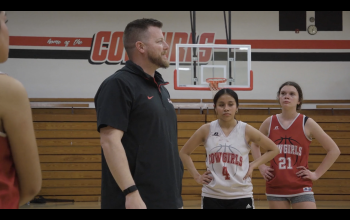Part 1 of 2
As the weather starts to warm up, we are used to seeing eager young people skipping around town happily looking forward to school letting out for the summer. This year though, things have been very different. Most students have not set foot in a school for almost two months due to concerns over COVID-19. However, that certainly does not mean that learning is not occurring.
For the Clarion-Goldfield-Dows School District, Friday, March 13 was the last normal day. At that point, most teachers, administrators and students probably would not have guessed that that would be the last time they would convene together in their schools and classrooms. Since then, Governor Kim Reynolds closed schools for the remainder of the year and gave districts options. They could offer students continuous learning, either mandatory or voluntary, and have instructional time requirements waived. Or they could basically do nothing and have to make up the school time later.
As has been reported upon in the Monitor previously, C-G-D elected to go with “voluntary educational enrichment opportunities.” Dr. Bob Olson, C-G-D Superintendent, has explained that this was the best choice for the district, since not every student has a device to complete instruction electronically nor does every family have the internet. C-G-D is not alone in making this decision. According to the Legislative Services Agency, 285 Iowa districts have opted for voluntary educational enrichment which mandates no grading or credit given. Five districts are requiring all students to participate, with attendance taken and work graded with credit given. And 37 school districts are doing a combination of the two.
Now, a few weeks after committing to voluntary learning opportunities, the district’s administrators are taking stock and see both ups and downs in what has become the new normal. At the high school level, Principal Sheila Hudson says she is seeing about 68% of students participate in learning. She explains that her staff is offering wide-ranging instruction. “Teachers are hosting a variety of experiences for students. Many teachers are connecting via Zoom to provide instruction and feedback. Students can participate live and interact with the instructor and their peers. In addition, teachers are recording lectures and meetings and sending them out so that students can watch at their convenience.”
Statewide, it seems like the high school level has been the most difficult when it comes to motivating students to work on a voluntary basis. Several schools have even felt it was best to move from voluntary to mandatory learning for this age group. North Iowa Community School in Buffalo Center was one of these. After the district was seeing only about 50% levels of participation, their school board voted in mid-April to make online work required for their high schoolers.
Locally, teachers are facing some of the same struggles. Brandon Lantzky, who teaches US History II, Economics, and History of the Vietnam War at C-G-D High School, said, “I would be happy if there was one student that is willing to do the work. With everything that is going on right now, I can understand why students would not want to voluntarily work. That being said, I am a little disappointed with the number of students that have participated in the Zooms that have been held. I have 66 US History II students (Sophomores), and on average, I see 7 students on the zoom. The amount of work that is turned in is even less.”
At the middle school level, Principal Steve Haberman is seeing better numbers for participation. “It’s dropped off a little with the nicer weather, but on a low day, we’re at about 60% participation and over 80% on the best days. I think it’s going extremely well.”
Haberman says he is proud of what his teachers have been doing to connect with and teach students. He explained that each content area like math, science and ELA are offered twice a week with two times in the day for students to log onto Zoom and participate. Haberman says that typically 15 minutes of instruction are offered with some work time built into the session. Afterwards, teachers might stay online for extra help and to answer questions. A quiz or some other activity may be offered as well.
The goal is not a bunch of homework but rather making the most of the situation. “We want to provide students a meaningful experience,” says Haberman. He compared trying to reach and interest his middle schoolers to going fishing every day. “Sometimes we need to try different bait, try a different time of day, or maybe even a new boat entirely,” he affirms. “But if we work hard, we can hook ‘em.”
Elementary Principal Tricia Rosendahl also discusses working hard to interest the youngest C-G-D students. She says she and her staff will be adding new material throughout May. “Students will enjoy some new challenges we will be pushing out to them during this last month of school to keep them engaged and excited about the learning.”
Rosendahl says they too have offered a varied approach to their instruction. Printed packets are sent out. The second through fifth grade students recently had the opportunity to pick up their own devices, with plans to offer them in the near future to Kindergarten and first graders. Teachers have even started doing some Zoom sessions with the district’s youngest students. Rosendahl adds that parents are encouraged to be present to help with the technology. She reports about 50% to 60% participation on the sessions she has been part of.
All the principals emphasized that the participation numbers and returned work are not necessarily the most important measurements of success. Haberman said, “A lot of what we do is on the social and emotional side. We want to be there for our students. We want them to have fun and learn, but more importantly, we want to make sure they are safe and ok and have enough to eat.”
Rosendahl and Hudson also agreed that the classwork is not always the prime focus. Rosendahl said her staff works to make weekly contact with families and she noted that her teachers still take time to celebrate birthdays of students when they meet online. Hudson included that many high school clubs have still been connecting virtually, such as FFA, Friends and Spanish Club.
Despite their best efforts, this is been a tough pursuit for students and teachers alike. Frankly, school may not be the top priority at the moment given the difficult position families find themselves in. Dr. Olson admits that some students may struggle to participate in learning because they are working to help their families out or face other difficulties at home.
Olson adds that teachers too have had their ups and downs. Many have their children at home and have to juggle teaching their students in addition to family obligations. And even the best prepared teachers have to occasionally deal with their technology and internet failing them.
Overall, almost a month into the “new normal,” C-G-D principals and superintendent are largely positive about what they’ve seen. “It has been good. We appreciate staff stepping up to make things work,” said Olson. He credits the district’s plans for e-Learning this past winter as helping them prepare for what’s happening now. “We’re doing well, but we will continue to work on connectivity, and I think we’ll just get better in the future.”
Check back in next week’s Monitor for the continuation of this story to learn about the exciting learning opportunities that C-G-D teachers are offering.



